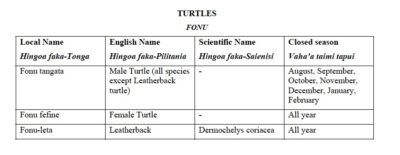Today we arrived in the Niua Island Group. The science team will spend the next two days surveying Niuatoputapu, while the education team will provide land-based education programs. These are also the last two days of our Tonga mission before we head back to mainland Tonga.
Protecting Tongan Sea Turtles
The archipelago of the Kingdom of Tonga is home to green sea turtles, Chelonia mydas,and hawksbill sea turtles, Eretmochelys imbricate. Populations of both species reside here year round and also migrate from other Pacific Islands to nest on the beaches.
In 2012, the Vava’u Turtle Monitoring Program was introduced under Vava’u Environmental Protection Association (VEPA), to identify and improve on the conservation methods for marine turtles in Tonga. For the first year, the project was funded by Ruffords Grants in England, and the project is planned to continue for a further 3 years. VEPA volunteer, Kate Walker, manages the project. The aims of the project are to improve on the knowledge and conservation of nesting sites, knowledge and conservation of important foraging grounds, and community eco-tourism development of both nesting and foraging sites.
Hawksbill sea turtle swimming on reef in Vava’u.
The last survey of nesting sites in Vava’u was carried out in 1978. Walker studied the beaches in Vava’u during the nesting season in 2012 and discovered nesting sites on 6 islands, 3 more than the study provided in 1978. VEPA is hoping to continue filling the gaps for the missing information for identification of nesting sites.
Conservation Status
Hawksbill turtles are listed as critically endangered under the IUCN Red List of 2008. They live in and around reefs feeding on corals and sponges. Additionally, green turtles are listed as endangered under the IUCN Red List, and they are found foraging on sea grass beds.
Regulations
Under the Fisheries Management (Conservation) Regulations 2008, here is the following schedule for marine turtles in Tonga:
24. Turtles
No person shall –
a) disturb, take, have in his possession, sell or purchase any turtle eggs;
b) interfere with, destroy, or disturb in any way any turtle nest;
c) use a spear or spear gun for the purpose of capturing, killing or taking any species of turtle;
d) at any time fish, capture or destroy any male turtle the shell length of which is less than 45 centimetres as illustrated in Schedule 9;
e) fish, capture or destroy any turtle during the closed season specified in Schedule 12; or So
f) fish, capture or destroy any Leatherback turtle of the species Dermochelys coriacea as specified in Schedule 12;
g) possess or sell turtle meat out of the shell, unless it has been certified by an authorised officer that it came from a turtle of legal size;
h) at any time, fish, harm, capture or destroy any female turtle as specified in Schedule 12.
Schedule 12
The above table shows the closed hunting seasons for sea turtles. Year round, no female turtles are allowed to be harvested and only male turtles may be caught between March and July. There are no take limits all year round for leatherback turtles. They are rarely sighted in Tonga and they are not known to nest on the beaches in Vava’u.
Regulation ‘d’ is one of the most difficult areas to enforce and monitor, because at 45 cm carapace (shell) length it is difficult to visually sex (gender identification) turtle species. Marine turtles have a slow growth rate from hatchlings until sexual maturity often over 15 – 20 years for many species, this means that recovery times for depleted populations can take many years to monitor and manage effectively.
Karen Stone measuring a hawksbill sea turtle’s carapace.
From the hatchlings less than 1% of those hatched will survive to become sexually mature, breeding adults. The hatchlings leave their nests and head towards the open ocean where they will float around on oceanic currents only returning to coastlines and foraging grounds when they are more developed.
Here is a rescued hawksbill sea turtle.
Currently, the project is monitoring sightings of sea turtles by both tourist operators and communities, and identifying foraging grounds and nesting sites within the Vava’u Island Group to develop strategies within the communities for the protection of both the species and the habitat. During the up coming nesting season, the project will continue to monitor and identify nesting sites around the island group.
Rescued green sea turtle.
With more Special Managed Areas (community protected areas) proposed for the Vava’u Island Group, we hope to work with these communities to monitor and protect nesting sites and foraging grounds on their islands, as well as climate change adaptation methods that may hinder the ability for sea turtles to nest on fragile coastlines.
The need for monitoring illegal harvesting during the closed and vital nesting season is a long process. There is a desperate need for communities to follow the regulations as stated to ensure the sustainability of the marine turtle populations in Tonga. Turtles that are able to be rescued and released are tagged during the project and the data collected is reported through VEPA.
VEPA members tagging a green sea turtle.
With this project, we hope to achieve a united and effective conservation effort for marine turtles and the traditions that surround them in Tonga. If there is a sustainable population of sea turtles that means the traditions may continue within Tonga.
Photos by: 1-5 Karen Stone






